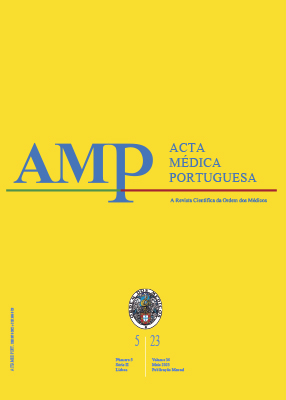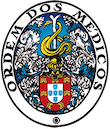Resurgence of Respiratory Syncytial Virus in Children: An Out-of-Season Epidemic in Portugal
DOI:
https://doi.org/10.20344/amp.18589Keywords:
Child, Palivizumab; Respiratory Syncytial Virus Infections/epidemiology, Respiratory Syncytial Virus Infections/prevention and control, Respiratory Syncytial Virus, HumanAbstract
Introduction: An out-of-season increase in respiratory syncytial virus (RSV) incidence was observed in Portugal from June 2021 onwards, revealing a continuing surge in cases throughout 2021/2022 autumn/winter. We aimed to describe this out-of-season epidemic and define its epidemic period, by analysing RSV incidence from week 40 of 2020 (2020-W40) to week 18 of 2022 (2022-W18).
Material and Methods: Surveillance data on weekly RSV laboratory confirmed cases, in Portugal, was used to monitor RSV incidence using CUSUM test methodology for count data.
Results: In 2021-W23, the CUSUM score identified a significant increase in the risk of RSV. By that time, the percentage of RSV positive tests rose from 1% in 2021-W22 (3/265) to 6% in 2021-W23 (18/298). Despite a sharp decrease in RSV incidence on 2021-W33 and on 2022-W02, the CUSUM score stayed over the limit up to 2022-W07, indicating that the RSV activity remained at an epidemic level. Distinct peaks of RSV cases were observed between 2021-W30 and 2021-W32 (average of 77 RSV cases per week) and between 2021-W39 and 2021-W41 (average of 79 RSV cases per week) with positivity rates around 60%.
Conclusion: An out-of-season RSV epidemic was identified, with a longer epidemic period compared with previous seasons. Possible reasons include relaxation of COVID-19 physical distancing measures and a greater proportion of population susceptible to disease. As several factors may change the pattern of RSV activity, countries should implement year-round surveillance RSV surveillance systems. These findings might have an impact on public health planning regarding future RSV surges, namely, on the palivizumab prophylaxis period for high-risk infants.
Downloads
References
Shi T, McAllister DA, O’Brien KL, Simoes EA, Madhi SA, Gessner BD, et al. Global, regional, and national disease burden estimates of acute lower respiratory infections due to respiratory syncytial virus in young children in 2015: a systematic review and modelling study. Lancet. 2017;390:946–58. DOI: https://doi.org/10.1016/S0140-6736(17)30938-8
Drysdale SB, Green CA, Sande CJ. Best practice in the prevention and management of paediatric respiratory syncytial virus infection. Ther Adv Infect Dis. 2016;3:63–71. DOI: https://doi.org/10.1177/2049936116630243
IMpact-RSV Study Group. Palivizumab, a humanized respiratory syncytial virus monoclonal antibody, reduces hospitalization from respiratory syncytial virus infection in high-risk infants. Pediatrics. 1998;102:531–7. DOI: https://doi.org/10.1542/peds.102.3.531
Staadegaard L, Caini S, Wangchuk S, Thapa B, de Almeida WA, de Carvalho FC, et al. Defining the seasonality of respiratory syncytial virus around the world: national and subnational surveillance data from 12 countries. Influenza Other Respir Viruses. 2021;15:732–41. DOI: https://doi.org/10.1111/irv.12885
Obando-Pacheco P, Justicia-Grande AJ, Rivero-Calle I, Rodríguez-Tenreiro C, Sly P, Ramilo O, et al. Respiratory syncytial virus seasonality: a global overview. J Infect Dis. 2018;217:1356–64. DOI: https://doi.org/10.1093/infdis/jiy056
Broberg EK, Waris M, Johansen K, Snacken R, Penttinen P, Trebbien R, et al. Seasonality and geographical spread of respiratory syncytial virus epidemics in 15 european countries, 2010 to 2016. Eurosurveillance. 2018;23:17-00284. DOI: https://doi.org/10.2807/1560-7917.ES.2018.23.5.17-00284
Instituto Nacional de Saúde Doutor Ricardo Jorge. Boletim de vigilância epidemiológica da gripe e outros vírus respiratórios. [Cited 2022 Aug 29]. Available from: https://www.insa.min-saude.pt/category/informacao-e-cultura-cientifica/publicacoes/atividade-gripal/.
Weinberger Opek M, Yeshayahu Y, Glatman-Freedman A, Kaufman Z, Sorek N, Brosh-Nissimov T. Delayed respiratory syncytial virus epidemic in children after relaxation of COVID-19 physical distancing measures, Ashdod, Israel, 2021. Euro Surveill. 2021;26:2017–21. DOI: https://doi.org/10.2807/1560-7917.ES.2021.26.29.2100706
Delestrain C, Danis K, Hau I, Behillil S, Billard MN, Krajten L, et al. Impact of COVID-19 social distancing on viral infection in France: a delayed outbreak of RSV. Pediatr Pulmonol. 2021;56:3669–73. DOI: https://doi.org/10.1002/ppul.25644
Britton PN, Hu N, Saravanos G, Shrapnel J, Davis J, Snelling T, et al. COVID-19 public health measures and respiratory syncytial virus. Lancet Child Adolesc Health. 2020;4:e42–3. DOI: https://doi.org/10.1016/S2352-4642(20)30307-2
Yeoh DK, Foley DA, Minney-Smith CA, Martin AC, MacE AO, Sikazwe CT, et al. Impact of coronavirus disease 2019 public health measures on detections of influenza and respiratory syncytial virus in children during the 2020 Australian winter. Clin Infect Dis. 2021;72:2199–202. DOI: https://doi.org/10.1093/cid/ciaa1475
Kutter JS, Spronken MI, Fraaij PL, Fouchier RA, Herfst S. Transmission routes of respiratory viruses among humans. Curr Opin Virol. 2018;28:142–51. DOI: https://doi.org/10.1016/j.coviro.2018.01.001
Rohani P, Green CJ, Mantilla-Beniers NB, Grenfell BT. Ecological interference between fatal diseases. Nature. 2003;422:885–8. DOI: https://doi.org/10.1038/nature01542
Nickbakhsh S, Mair C, Matthews L, Reeve R, Johnson PC, Thorburn F, et al. Virus-virus interactions impact the population dynamics of influenza and the common cold. Proc Natl Acad Sci USA. 2019;116:27142–50. DOI: https://doi.org/10.1073/pnas.1911083116
Casalegno JS, Ottmann M, Bouscambert-Duchamp M, Valette M, Morfin F, Lina B. Impact of the 2009 influenza A (H1N1) pandemic wave on the pattern of hibernal respiratory virus epidemics, France, 2009. Euro Surveill. 2010;15:2. DOI: https://doi.org/10.2807/ese.15.06.19485-en
Mak GC, Wong AH, Ho WY, Lim W. The impact of pandemic influenza A (H1N1) 2009 on the circulation of respiratory viruses 2009-2011. Influenza Other Respir Viruses. 2012;6:2009–13. DOI: https://doi.org/10.1111/j.1750-2659.2011.00323.x
Mollers M, Barnadas C, Broberg EK, Penttinen P, Teirlinck AC, Fischer TK, et al. Current practices for respiratory syncytial virus surveillance across the EU/EEA Member States, 2017. Euro Surveill. 2019;24:1900157. DOI: https://doi.org/10.2807/1560-7917.ES.2019.24.40.1900157
Teirlinck AC, Broberg EK, Berg AS, Campbell H, Reeves RM, Carnahan AS, et al. Recommendations for respiratory syncytial virus surveillance at the national level. Eur Respir J. 2021;58:2003766. DOI: https://doi.org/10.1183/13993003.03766-2020
McKimm-Breschkin JL, Hay AJ, Cao B, Cox RJ, Dunning J, Moen AC, et al. COVID-19, Influenza and RSV: Surveillance-informed prevention and treatment – Meeting report from an isirv-WHO virtual conference. Antiviral Res. 2022;197:105227. DOI: https://doi.org/10.1016/j.antiviral.2021.105227
World Health Organization. A manual for estimating disease burden associated with seasonal influenza. Geneva: WHO; 2015.
Statistics Portugal. Estimates of resident population. [Cited 2022 May 27]. Available from: https://www.ine.pt/xportal/xmain?xpid=INE&xpgid=ine_indicadores&indOcorrCod=0011166&xlang=pt.
Direção-Geral da Saúde. Norma 019/2020 COVID-19: Estratégia nacional de testes para SARS-CoV-2, atualizada 23/06/2022. p. 1–13. Lisboa: DGS; 2022.
Lim HJ, Park JE, Park MY, Baek JH, Jung S, Sung N, et al. Assay system for simultaneous detection of sars-cov-2 and other respiratory viruses. Diagnostics. 2021;11:1084. DOI: https://doi.org/10.3390/diagnostics11061084
ArcDia International Ltd. MariPOC® sensitivity and specificity. [Cited 2022 Sep 12]. Available from: https://www.arcdia.com/maripoc/performance/.
Peralta-Santos A, Saboga-Nunes L, Magalhães PC. A tale of two pandemics in three countries: Portugal, Spain, and Italy. In: Greer SL, King EJ, Fonseca EM, Peralta-Santos A, editors. Coronavirus politics: the comparative politics and policy of COVID-19. Michigan: University of Michigan Press; 2021. p. 361-77.
Greer SL, King EJ, da Fonseca EM, Peralta-Santos A. The comparative politics of COVID-19: the need to understand government responses. Glob Public Health. 2020;15:1413–6. DOI: https://doi.org/10.1080/17441692.2020.1783340
Torres AR, Rodrigues AP, Sousa-Uva M, Kislaya I, Silva S, Antunes L, et al. Impact of stringent non-pharmaceutical interventions applied during the second and third COVID-19 epidemic waves in Portugal, 9 November 2020 to 10 February 2021: an ecological study. Euro Surveill. 2022;27:1–12. DOI: https://doi.org/10.2807/1560-7917.ES.2022.27.23.2100497
República Portuguesa XXII Governo. Legislação COVID-19 [COVID-19 Legislation]. [Cited 2022 Feb 23]. Available from: https://dre.pt/dre/geral/legislacao-covid-19.
Faverjon C, Berezowski J. Choosing the best algorithm for event detection based on the intend application: a conceptual framework for syndromic surveillance. J Biomed Inform. 2018;85:126–35. DOI: https://doi.org/10.1016/j.jbi.2018.08.001
Cowling BJ, Wong IO, Ho LM, Riley S, Leung GM. Methods for monitoring influenza surveillance data. Int J Epidemiol. 2006;35:1314–21. DOI: https://doi.org/10.1093/ije/dyl162
Lucas JM. Counted data cusum’s. Technometrics. 1985;27:129–44. DOI: https://doi.org/10.1080/00401706.1985.10488030
Menotti J, Porcher R, Ribaud P, Lacroix C, Jolivet V, Hamane S, et al. Monitoring of nosocomial invasive aspergillosis and early evidence of an outbreak using cumulative sum tests (CUSUM). Clin Microbiol Infect. 2010;16:1368–74. DOI: https://doi.org/10.1111/j.1469-0691.2010.03150.x
Midgley CM, Haynes AK, Baumgardner JL, Chommanard C, Demas SW, Prill MM, et al. Determining the seasonality of respiratory syncytial virus in the United States: the impact of increased molecular testing. J Infect Dis. 2017;216:345–55. DOI: https://doi.org/10.1093/infdis/jix275
Hawkins DM, Olwell DH, Wang B. CUSUMdesign: Compute decision interval and average run length for CUSUM charts. [Cited 2022 Sep 4]. Available from: https://cran.r-project.org/web/packages/CUSUMdesign/CUSUMdesign.pdf.
Hall LM, French JP. A modified CUSUM test to control postoutbreak false alarms. Stat Med. 2019;38:2047–58. DOI: https://doi.org/10.1002/sim.8088
R Core Team. R: A language and environment for statistical computing. Vienna, Austria: R Foundation for Statistical Computing; 2017. [Cited 2022 Feb 23]. Available from: https://www.r-project.org/.
Escola Nacional de Saúde Pública. Opinião Social: Perceção de risco dos portugueses baixou e jovens com piores valores de saúde mental. [Cited 2022 Feb 23]. Available from: https://barometro-covid-19.ensp.unl.pt/opiniao-social-percecao-de-risco-dos-portugueses-baixou-e-jovens-com-piores-valoresde-saude-mental/.
Ujiie M, Tsuzuki S, Nakamoto T, Iwamoto N, Ujiie M. Resurgence of respiratory syncytial virus infections during covid-19 pandemic, Tokyo, Japan. Emerg Infect Dis. 2021;27:2969–70. DOI: https://doi.org/10.3201/eid2711.211565
Foley DA, Yeoh DK, Minney-Smith CA, Martin AC, Mace AO, Sikazwe CT, et al. The interseasonal resurgence of respiratory syncytial virus in Australian children following the reduction of coronavirus disease 2019-related public health measures. Clin Infect Dis. 2021;73:e2829–30. DOI: https://doi.org/10.1093/cid/ciaa1906
Hatter L, Eathorne A, Hills T, Bruce P, Beasley R. Respiratory syncytial virus: paying the immunity debt with interest. Lancet Child Adolesc Heal. 2021;5:e44–5. DOI: https://doi.org/10.1016/S2352-4642(21)00333-3
Tenenbaum T, Doenhardt M, Diffloth N, Berner R, Armann JP. High burden of RSV hospitalizations in Germany 2021-2022. Infection. 2022:1–4. DOI: https://doi.org/10.1007/s15010-022-01889-6
Loconsole D, Centrone F, Rizzo C, Caselli D, Orlandi A, Cardinale F, et al. Out-of-season epidemic of respiratory syncytial virus during the COVID-19 pandemic: the high burden of child hospitalization in an academic hospital in southern Italy in 2021. Children. 2022;9:848. DOI: https://doi.org/10.3390/children9060848
Google. COVID-19 Community mobility reports. [Cited 2022 Aug 3]. Available from: https://www.google.com/covid19/mobility.
van Summeren J, Meijer A, Aspelund G, Casalegno JS, Erna G, Hoang U, et al. Low levels of respiratory syncytial virus activity in Europe during the 2020/21 season: what can we expect in the coming summer and autumn/winter? Euro Surveill. 2021;26:2100639. DOI: https://doi.org/10.2807/1560-7917.ES.2021.26.29.2100639
Direção-Geral da Saúde. Norma no 012/2013 de 30/07/2013: Prescrição de palivizumab para prevenção de infeção pelo vírus sincicial respiratório em crianças de risco. Lisboa: DGS; 2013.
Direção-Geral da Saúde. Norma no 021/2021 de 08/09/2021: Antecipação, excecional, do período de administração do palivizumab, para prevenção da infeção pelo vírus sincicial respiratório em crianças de risco, para a época 2021-2022 [Regulation n. 021/2021 in 08/09/2021]. Lisboa: DGS; 2021.
Direção-Geral da Saúde. Despacho no 004/2022 de 09/02/2022: Conclusão do período excecional de administração do palivizumab, para prevenção da infeção pelo vírus sincicial respiratório em crianças de risco, na época 2021-2022. Lisboa: DGS; 2022.
Baker RE, Park SW, Yang W, Vecchi GA, Jessica C, Grenfell BT. The impact of COVID-19 nonpharmaceutical interventions on the future dynamics of endemic infections. Proc Natl Acad Sci U S A. 2020;117:30547–53. DOI: https://doi.org/10.1073/pnas.2013182117
Zheng Z, Pitzer VE, Shapiro ED, Bont LJ, Weinberger DM. Estimation of the Timing and Intensity of Reemergence of Respiratory Syncytial Virus Following the COVID-19 Pandemic in the US. JAMA Network Open. 2021;4:e2141779. DOI: https://doi.org/10.1001/jamanetworkopen.2021.41779
Agha R, Avner JR. Delayed seasonal RSV surge observed during the COVID-19 pandemic. Pediatrics. 2021;148: e2021052089. DOI: https://doi.org/10.1542/peds.2021-052089
Paes BA, Craig C, Pigott W, Latchman A. Seasonal respiratory syncytial virus prophylaxis based on predetermined dates versus regional surveillance data. Pediatr Infect Dis J. 2013;32:360–4. DOI: https://doi.org/10.1097/INF.0b013e31829479d3
Instituto Nacional de Saúde Doutor Ricardo Jorge. COVID-19: curva epidémica e parâmetros de transmissibilidade. [Cited 2022 Sep 15]. Available from: http://www.insa.min-saude.pt/category/areas-de-atuacao/epidemiologia/covid-19-curva-epidemica-e-parametros-de-transmissibilidade/.
Machado A, Gomez V, Panarra A, Poças J, Corte-Real R, Peres MJ, et al. Implementing an influenza vaccine effectiveness study in a hospital context in Portugal: The EVA Hospital Project. Acta Med Port. 2020;33:20–7. DOI: https://doi.org/10.20344/amp.13438
Bagaria J, Jansen T, Marques DF, Hooiveld M, McMenamin J, de Lusignan S, et al. Rapidly adapting primary care sentinel surveillance across seven countries in Europe for COVID-19 in the first half of 2020: strengths, challenges, and lessons learned. Euro Surveill. 2022;27:2100864. DOI: https://doi.org/10.2807/1560-7917.ES.2022.27.26.2100864
Borchers AT, Chang C, Gershwin ME, Gershwin LJ. Respiratory syncytial virus - a comprehensive review. Clin Rev Allergy Immunol. 2013;45:331–79. DOI: https://doi.org/10.1007/s12016-013-8368-9
Rodrigues AP, Guiomar R, Torres AR, Melo A, Bandeira T, Azevedo I, et al. Severity of RSV infections in hospitalized children under 2 years of age: Portuguese experience from the first year of national surveillance. Belfast: 12th International RSV Symposium; 2022.
Downloads
Published
How to Cite
Issue
Section
License
Copyright (c) 2023 Acta Médica Portuguesa

This work is licensed under a Creative Commons Attribution-NonCommercial 4.0 International License.
All the articles published in the AMP are open access and comply with the requirements of funding agencies or academic institutions. The AMP is governed by the terms of the Creative Commons ‘Attribution – Non-Commercial Use - (CC-BY-NC)’ license, regarding the use by third parties.
It is the author’s responsibility to obtain approval for the reproduction of figures, tables, etc. from other publications.
Upon acceptance of an article for publication, the authors will be asked to complete the ICMJE “Copyright Liability and Copyright Sharing Statement “(http://www.actamedicaportuguesa.com/info/AMP-NormasPublicacao.pdf) and the “Declaration of Potential Conflicts of Interest” (http:// www.icmje.org/conflicts-of-interest). An e-mail will be sent to the corresponding author to acknowledge receipt of the manuscript.
After publication, the authors are authorised to make their articles available in repositories of their institutions of origin, as long as they always mention where they were published and according to the Creative Commons license.









